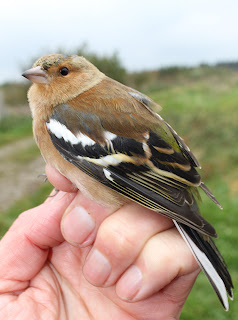It was a touch breezy but clear and starry overhead last night as I stepped outside the back door at 8.30 and then 9.00pm pm listening for Redwings, because Will and I had arranged to try and catch a few at Rawcliffe Moss this morning. I didn’t hear the high pitched “seep, seep” of Redwings, but after the last few days of both Redwings and Fieldfares turning up in most places I wasn’t too worried there wouldn’t be at least a few around come 6.30am. The first birds we heard were in fact noisy Blackbirds and Song Thrushes arriving from the blackness, but within ten or fifteen minutes the Redwings appeared from the north, and we caught our first one of the autumn.


For any readers unfamiliar with the thrill of hearing the flight calls of these long distance migrants through the darkness of an October night or arriving overhead at dawn, here’s an example.
From 0630 to 1130am we enjoyed a totally absorbing morning of both birding and ringing and caught birds steadily. At the same time we witnessed a fairly continuous stream of visible migration, even if at times the clearness of the sky frustrated our attempts to actually see many of the birds that called overhead.
We caught 28 new birds of 11 species, recaptured a Robin from some weeks ago, but also controlled a Reed Bunting, i.e. not our ring - X982264 anyone?
New birds - 6 Redwing, 4 Chaffinch, 7 Reed Bunting, 2 Robin, 2 Great Tit, 2 Wren, and 1 each of Blackbird, Song Thrush, Lesser Redpoll, Jay and Dunnock.




Redwing were the most numerous migrant this morning with a total of approximately 300 birds arriving from the north in mixed groups numbering from less than 4 birds, into tens and twenties and the highest number a flock of approximately 70 birds. Our Fieldfare count was 14 birds only, plus 7 Song Thrush and 10 Blackbird.
The other migration stars this morning were the finch family and Reed Buntings. While we caught 7 Reed Buntings we counted at least 20 birds overhead or close to us along the ditch, in the potato field or simply flying over calling. In addition there was a single Corn Bunting. Our visible migration of finches totalled 50 Chaffinch, 20 Siskin, 10 Redpoll, 8 Greenfinch and 1 Brambling, all these counts certainly underestimates in the clear conditions.
Unlike in past weeks we didn’t set out to catch Meadow Pipits today, our target species changed of necessity into Redwing, Fieldfare and Reed Bunting, so in that sense we partly succeeded. Had we sought Meadow Pipits we may have caught several since the overhead north to south count for this species was 70 birds.
Other birds seen this morning; 1 female Sparrowhawk, 175 Lapwing, 2 Golden Plover, 1 Kestrel, 2 Jay, 60+ Skylark.
Of course Will was in Scotland last week and I had said I would bag more birds while he was away than he would land salmon. He got lucky and I got seriously unlucky - fifty-three salmon caught between four of them! Now that is a proper catch. My excuse was the week of unfriendly ringing weather that let me out once whilst he and Sue obviously made the best of ideal salmon fishing weather. Anyway thanks for the piece of salmon Will and Sue, I left it to defrost and it will definitely taste better than humble pie.

The weather looks perfect for tomorrow too. We might just have to do it all over again.













































































